Effect of build orientation on the green tribological properties of multi-jet fusion manufactured PA12 parts
IF 1.8
3区 工程技术
Q3 ENGINEERING, MECHANICAL
Proceedings of the Institution of Mechanical Engineers, Part J: Journal of Engineering Tribology
Pub Date : 2023-11-01
DOI:10.1177/13506501231209396
引用次数: 0
Abstract
Additive manufacturing (AM) is a newly developed technology for manufacturing parts from three-dimensional (3D) computer-aided design (CAD) models by depositing a material layer on layer. Multi-jet fusion (MJF) is one of the AM technologies that can be used for manufacturing functional parts like gear, linear, bearing, etc., by polymers. In various applications, technical processes, design of tribological systems, optimum lubrication, and reduction of wear and friction are significant performance criteria to provide energy and material conservation. The development of green tribological applications offers essential solutions to problems of ecosystem pollution and energy from a global point of view to increase sustainability. In this article, the green tribological behavior of Polyamide 12 (PA12) parts, manufactured by MJF with different build orientations was evaluated by ball-on-disc tribological tests under different normal loads and lubricated environments. Mechanical profilometer and digital microscope were used to evaluate surface quality and morphology. Scanning electron microscope (SEM) was used to determine the samples’ wear characteristics. The maximum surface roughness was measured for the part having a build orientation of 45°. The maximum coefficient of friction value was determined as 0.355 for the sample with 45° orientation under 5 N load and dry environment. The maximum wear rate value was determined as 2.3249 × 10 −4 mm 3 /Nmm for the sample with 0° orientation under 10 N load and dry state. The differences between build orientations should be considered when evaluating tribological properties. This article provides a new perspective to researchers and practitioners toward green tribology of polymer AM parts.构建取向对多喷流熔制PA12零件绿色摩擦学性能的影响
增材制造(AM)是一种新发展起来的技术,通过一层一层地沉积材料,从三维(3D)计算机辅助设计(CAD)模型制造零件。多射流融合(MJF)是一种增材制造技术,可用于制造功能部件,如齿轮,线性,轴承等,由聚合物。在各种应用中,技术流程、摩擦学系统的设计、最佳润滑、减少磨损和摩擦是提供能源和材料节约的重要性能标准。绿色摩擦学应用的发展从全球的角度为生态系统污染和能源问题提供了必要的解决方案,以提高可持续性。在不同的正常载荷和润滑环境下,通过球盘摩擦试验,对MJF公司生产的具有不同构造取向的聚酰胺12 (PA12)零件的绿色摩擦学性能进行了评价。采用机械轮廓仪和数码显微镜对表面质量和形貌进行评价。采用扫描电镜(SEM)对试样的磨损特性进行了分析。最大表面粗糙度测量的部分具有45°的构建方向。在5 N载荷和干燥环境下,45°取向试样的最大摩擦系数为0.355。在10 N载荷和干燥状态下,0°取向试样的最大磨损率为2.3249 × 10−4 mm 3 /Nmm。在评估摩擦学性能时,应考虑构建方向之间的差异。本文为高分子增材制造零件的绿色摩擦学研究提供了新的视角。
本文章由计算机程序翻译,如有差异,请以英文原文为准。
求助全文
约1分钟内获得全文
求助全文
来源期刊

CiteScore
4.20
自引率
5.00%
发文量
110
审稿时长
6.1 months
期刊介绍:
The Journal of Engineering Tribology publishes high-quality, peer-reviewed papers from academia and industry worldwide on the engineering science associated with tribology and its applications.
"I am proud to say that I have been part of the tribology research community for almost 20 years. That community has always seemed to me to be highly active, progressive, and closely knit. The conferences are well attended and are characterised by a warmth and friendliness that transcends national boundaries. I see Part J as being an important part of that community, giving us an outlet to publish and promote our scholarly activities. I very much look forward to my term of office as editor of your Journal. I hope you will continue to submit papers, help out with reviewing, and most importantly to read and talk about the work you will find there." Professor Rob Dwyer-Joyce, Sheffield University, UK
This journal is a member of the Committee on Publication Ethics (COPE).
 求助内容:
求助内容: 应助结果提醒方式:
应助结果提醒方式:


